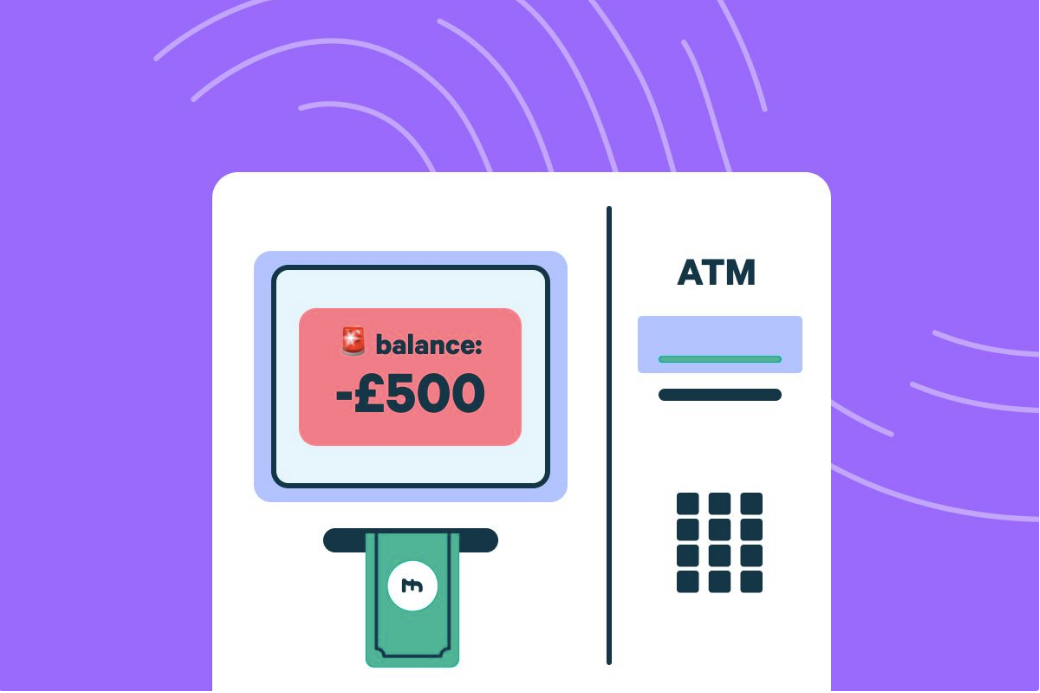Table of Contents
What is an overdraft?
An overdraft is effectively a form of debt attached to your bank account. If your account goes into negative figures because you’ve spent more than your balance, you’ll be overdrawn and owe money to your bank.
An overdraft can sometimes be a handy tool to manage your money, but also a significant problem if not used correctly 🛑
And if you’re trying to pay back your overdraft, you probably know how difficult it can be to stop relying on a bank account overdraft once you’ve got into the habit. Especially with current interest rates of nearly 40%!
Although it can be a challenge to break the cycle... you’re not alone. 58% of Plum customers will be overdrawn on their current account this month, with 6% spending the entire month in 'the red'. Thankfully, there’s help at hand, so read on to find out more about how to pay back your overdraft and if you can pay off your overdraft in instalments 🤝
How does an overdraft work?
Your overdraft will be either arranged or unarranged. An arranged overdraft means your bank has given you permission to use an overdraft. An unarranged overdraft means the bank hasn’t agreed in advance that you can go overdrawn.
Sometimes your bank will require you to apply for an overdraft, rather than it automatically being there.
How to use your overdraft will often depend on your bank 🏦 Some banks allow you to go overdrawn simply by spending more money than you have available. Some banks send alerts before a payment to ask if you wish to use your overdraft, while others may decline your payment if you haven’t arranged an overdraft.
What are overdraft interest rates?
Like other loans, your provider will likely charge interest in return for lending you money. The interest will be charged as a percentage of the money you borrow.
You can work out how much interest you’ll pay from an account's APR (Annual Percentage Rate) or EAR (Effective Annual Rate). APR includes all charges, whereas EAR only includes interest payments. The higher the rate, the more interest you’ll pay.
Previously, if you went into your overdraft unarranged or didn’t repay within sufficient time, you’d be liable to significant bank charges. However, as of April 2020, the FCA prevents banks from charging fees for unarranged overdrafts or late payments. And banks can no longer charge different interest rates for arranged and unarranged overdrafts.
To make up for lost revenue, most banks have since increased their overdraft interest rates to around 39.9%. Santander, Lloyds Banking Group (including Halifax) and HSBC all have a 39.9% overdraft interest rate as of October 2021. This is double the rate of most credit cards.
If you’re a student, you may be able to access a 0% overdraft. This means you won't pay any interest on the money you borrow (provided it’s within the account’s arranged overdraft limit).
Does an overdraft affect your credit score?
In short, yes, your overdraft could affect your credit score. But, this isn’t necessarily a bad thing.
If you use your overdraft in moderation and regularly pay off what you borrow, it could actually help your credit score, by showing your ability to handle debt.
However, if you use an unarranged overdraft, or permanently live within your overdraft, this could have a negative impact on your credit score. Having a negative credit score could hinder your ability to receive loans in the future, such as a mortgage 🏡
Is being in your overdraft a problem?
Being in your overdraft isn’t necessarily a problem, so long as it’s arranged and you’re paying back the money in sufficient time.
Some people may find overdrafts useful for providing a small financial buffer, where bills can be paid in the days before payday. Overdrafts can also be a useful way for students to learn about budgeting and debt, all on a low-interest rate 🧑🎓
However, for most people interest rates do remain high. Using an unarranged overdraft or not paying back your overdraft in the long term can be very expensive and create unnecessary stress. You should use your overdraft with attention.
And, even if you do manage your overdraft effectively, any financial whiz will likely tell you that the first step in any meaningful financial strategy is to clear debt, and that also includes overdrafts too.
How do you pay back an overdraft?
So now you’ve decided you want to pay back your overdraft, how does this work? No fear, we have a variety of tips and tricks available 😍
Use your savings
This solution may not be immediately obvious or desirable. But, if you have savings, it’s nearly always advantageous to use these to pay off your debt.
When you’re potentially charged 40% interest on your overdraft, it doesn’t make sense to be racking up interest while your savings are left unused.
Though it may be hard to say goodbye to your hard earned savings, you’ll save more money in the long term by getting those high interest rates out the way. After all, this is the type of scenario your emergency fund is built for 🚑
Switch banks
Just because you’re in your overdraft doesn’t mean you’re chained to that bank. Switching to an account with lower interest rates can help you start paying off the balance you owe, rather than your account’s interest.
Switching to a different bank is easy, and can be done with the Current Account Switch Service. It’s worth shopping around for the best possible deal for you and your financial situation.
However, it’s very important to check that you’re actually getting a better deal on your new account and that you’re eligible to apply for an arranged overdraft. Consider any switching charges from your current provider, or any rewards you may receive from your new one 💰
Switch to a credit card
Though credit cards come with their own challenges, they can also provide a solution to overdraft debt. Especially now that overdraft interest rates are higher than many credit cards.
There are a variety of 0% credit cards available if you can’t access a 0% overdraft. And we’ve even made them easier to find and compare, with our Lost Money feature in the Plum app 👀
You can arrange a transfer from overdraft to credit card with a money transfer credit card. You’ll have to pay about 3 to 4% of the amount you’re transferring, but what you owe will move onto the card at 0% interest. These cards can offer 0% interest for up to 18 months 💳
Can I pay off my overdraft in instalments?
In short, yes, there's nothing to stop you paying off your overdraft in instalments. Overdrafts don’t come with any set repayment plan, like many personal loans do. This means you’re left to pay back your overdraft as you wish.
Though this means you don’t have any official instalments to guide you in paying your debt, there’s nothing to stop you creating your own personal instalment plan, where you aim to pay back a set amount each month 🗓
What if I have multiple debts?
If you’re struggling to pay several debts at once, chances are high interest rates or fees are partly responsible for your failed attempts to break free 🕊
This is why it’s important to always tackle the debt with the highest rate of interest first, whether that’s your overdraft or credit card. This allows you to avoid your most expensive debt stacking up, and to buy you some breathing space as you pay back your debt.
For example, if you have an overdraft at 39.9% and a credit card at say 20%, it’s advisable to pay off your overdraft first.
If you’re really struggling to keep up with all your loans at the same time, it may be worth looking at a debt consolidation loan. This combines all your various debts together into one single loan, which could make your debt easier to manage and potentially lower the amount of interest you pay.
Also be aware that if you’re really struggling with debt, there are trained experts to guide you through this process. Organisations like the Citizens Advice Bureau or National Debtline are there to offer support. Help is always there if you need it 🦄
How to clear your overdraft debt with Plum’s Overdraft Savings
If your spending habits make it hard to clear your overdraft, then budgeting and saving will be key skills in helping you better manage your money. Luckily this is where Plum’s money management app makes it easier for you.
With our Overdraft Savings feature, we’ll help you save more money from your income, in order to plug the hole in your debt.
Since the best time to regularly put aside money is when you first get paid, Plum will automatically deposit a lump sum to your Plum account when your salary first hits your bank account 💸 This way you’ll save the money before life has a chance to get in the way.
We know that setting money aside despite being unable to repay your overdraft in full may seem counter-intuitive. But, this short-term pain can hopefully help you maximise your savings over the long-term.
For example, if you normally reach a bank balance of -£100 before payday, then Plum will make savings for you without taking you below this amount. Humans tend to be hard-wired to spend what’s available, so the idea here is that you still reach payday with the same balance... though, now with the benefit of having some money tucked away to pay off that overdraft 💰
You can enable Overdraft Savings within the Plum app by heading to the 'brain' section within the app and tapping 'overdraft savings' 📲
Other Plum Savings Rules to help with your overdraft
But, we’re not done there. Plum has a host of other ways to help you better manage your money and cut down on overdraft debt, whether big or small.
Plum can give you an overview of all your bank accounts and credit cards in a single view, which can help you see what money you have available to spend, and help cut down your spending.
Our Money Maximiser can help you stay on budget, by automating withdrawals to your bank account in time for payments and earning you interest in the meantime.
Plum can also help you find the best deals on loans, as well as saving you money on everything from credit cards to household utility bills.
And features like Rainy Days will gamify your saving to make sure it’s enjoyable and that you stick at it 👾 We hope you’ll be overdraft free before you know it!
To learn more about Plum you can check out our website.
And if you've managed to pay off your overdraft, you might consider building up your savings with the help of our guide on how to save.
If you’re looking for more ways to save money then cancelling any unwanted or forgotten subscription services is a great place to start! We have guides for cancelling: Audible, British Gas, BT, Equifax, Experian, G2A, GiffGaff, Grindr, HelloFresh, ID Mobile, Lycamobile, MBNA, Monzo, National Lottery, Octopus Energy, Only Fans, Prime Video, RAC, Scottish Power, Shell Energy, Sky Email, Sky Mobile, Tesco Mobile, Thames Water, Udemy, Utilita, Vimeo, Virgin Media, Voxi, Weight Watchers, YouTube Music.
Download PlumFor all the latest Plum news and discussion, head to our Plummunity Forum, or follow us on Instagram and Twitter.

